Chinese sculpture
Here's a compilation of my favorite items from the genres on permanent display at the Art Institute. Some of these things are in the place where I saw them on my first visit -- about 40 years ago -- but some are more recent - and I've painfully learned that nothing is on permanent display. So I thought I'd take a moment to document what I like the most.

This Tang Boddisatva is my favorite piece in the museum -- and given it's prominent location -- I don't think I'm alone in my admiration for it.
 Front view of the same sculpture (taken with my new "image stabilized" camera)
Front view of the same sculpture (taken with my new "image stabilized" camera)
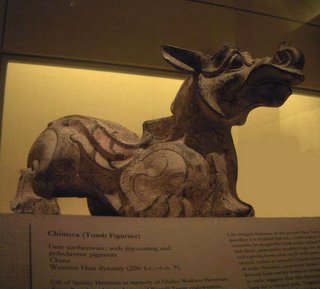
Cute little doggie, isn't he ? Found in a Han tomb - but it seems like it would also work as a roof-top decoration.

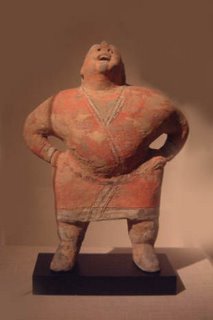
This jovial fellow was found in a 6th C. AD tomb -- thought to be an entertainer.
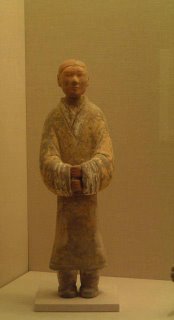
A Han dynasty tomb figure - with an especially thoughtful expression, don't you think ?
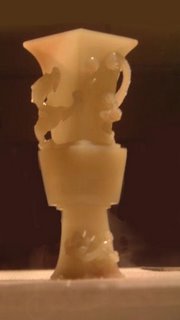
I'm not a big fan of jade -- I think it's so hard to work, the issue of design is
made secondary. But this Ming era chalice with dragons is one of the nicer pieces. Can you imagine actually sipping from it ?
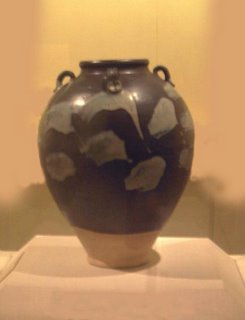
This is my favorite Tang vase in the collection -- those white splotches are more than just splotches -- they're alive -- like an airborn flock of geese.
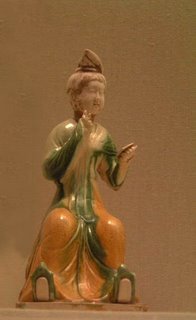

These delightful, rainbow-colored girls have always pulled me into their private little boudoirs. They're about the right age for the pavillions in "Dream of Red Chamber", but they lived 1,000 years earlier.

For whatever reason, China doesn't seem to have portrait sculpture of ancestors --
I'm guessing that's because the power of the head-of-family is so absolute, everyone is relieved when he's finally gone. But monastaries are the exception - where maybe those lonely guys really did miss those who have died. This is an 11th Century
piece -- hollow with a lacquer surface.
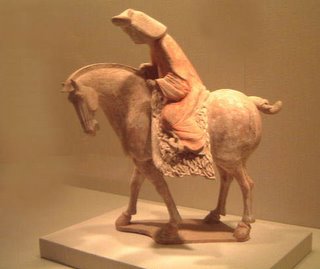
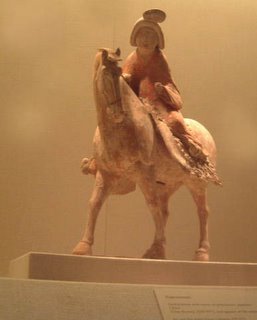
Another one of my 40-year favorites - see how even an unusual vantage point offers a delightful view. So soft -- so gentle -- so stately -- the happy, idyllic world
of Tang. Why couldn't it last forever ?
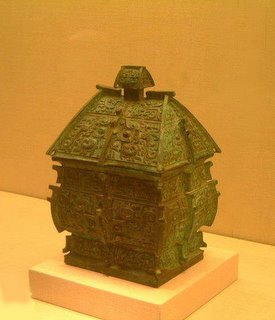
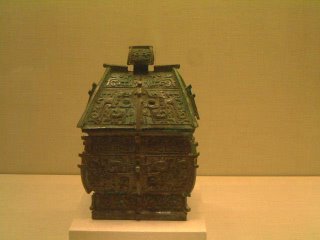
I've never been able to imagine myself in a social event that would use these architectural wine jars from the Zhou dynasty (1050 - 770 BC )


They have whimsy and power, don't they ? As if they contained something more important than wine. They seem to belong in a room into which no one is allowed to enter.

This Tang Boddisatva is my favorite piece in the museum -- and given it's prominent location -- I don't think I'm alone in my admiration for it.
 Front view of the same sculpture (taken with my new "image stabilized" camera)
Front view of the same sculpture (taken with my new "image stabilized" camera)
Cute little doggie, isn't he ? Found in a Han tomb - but it seems like it would also work as a roof-top decoration.


This jovial fellow was found in a 6th C. AD tomb -- thought to be an entertainer.

A Han dynasty tomb figure - with an especially thoughtful expression, don't you think ?

I'm not a big fan of jade -- I think it's so hard to work, the issue of design is
made secondary. But this Ming era chalice with dragons is one of the nicer pieces. Can you imagine actually sipping from it ?

This is my favorite Tang vase in the collection -- those white splotches are more than just splotches -- they're alive -- like an airborn flock of geese.


These delightful, rainbow-colored girls have always pulled me into their private little boudoirs. They're about the right age for the pavillions in "Dream of Red Chamber", but they lived 1,000 years earlier.

For whatever reason, China doesn't seem to have portrait sculpture of ancestors --
I'm guessing that's because the power of the head-of-family is so absolute, everyone is relieved when he's finally gone. But monastaries are the exception - where maybe those lonely guys really did miss those who have died. This is an 11th Century
piece -- hollow with a lacquer surface.


Another one of my 40-year favorites - see how even an unusual vantage point offers a delightful view. So soft -- so gentle -- so stately -- the happy, idyllic world
of Tang. Why couldn't it last forever ?


I've never been able to imagine myself in a social event that would use these architectural wine jars from the Zhou dynasty (1050 - 770 BC )


They have whimsy and power, don't they ? As if they contained something more important than wine. They seem to belong in a room into which no one is allowed to enter.


2 Comments:
Interesting that the Tang bodhisattva is your favorite piece. I've seen it many times and have actually stopped to study it probably half a dozen times, usually on my way into the Japanese galleries. I wouldn't say it's my favorite, although I certainly like it. My favorite, if i had to choose, would probably be a neighbor of his: the Nara Boddisattva from Todai-ji.
However, I now want to go back and re-experience this Tang sculpture. I like the playful cock of the head, not something I ususallly expect from a Buddha-apparent. He has the strong body of Tang religious figures: not so lithe and wispy like those of the Qing and Ming. But he's got spunk and quirkiness that seem to make him more approchable than, say, the pacific, beautific but more aloof granite Buddha from Chola Tamil Nadu.
You mean this guy ?
You're really into peacefulness, aren't you ?
I'll take a look at it next time -- but I don't expect I'll be switching allegiances.(though I hope I make it to Nara someday)
Post a Comment
<< Home